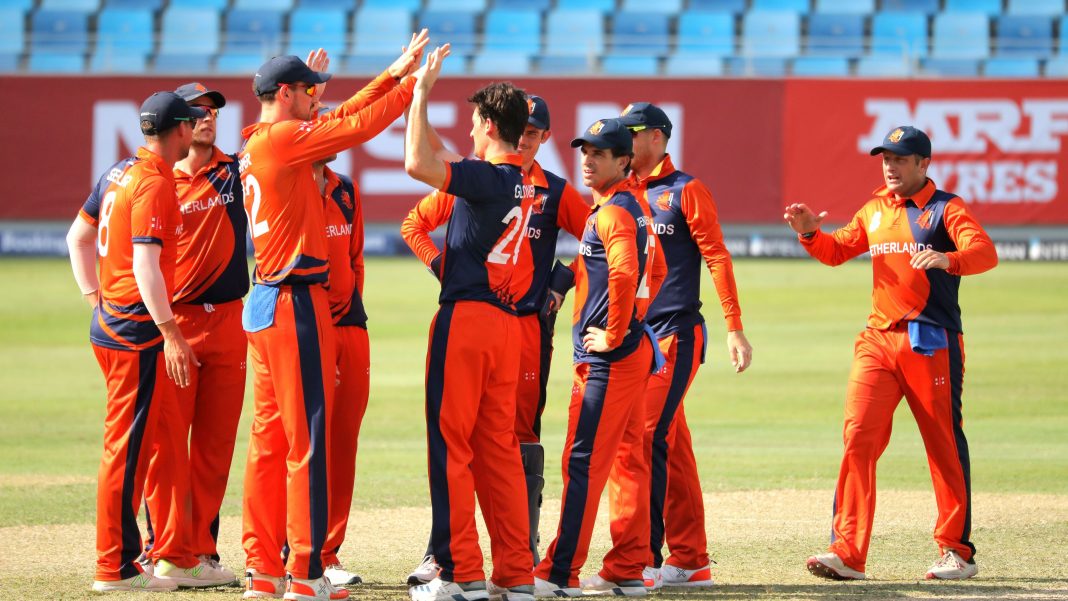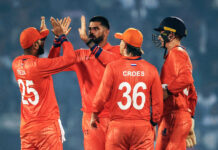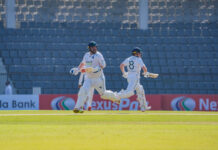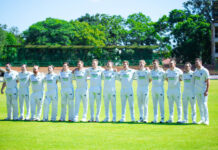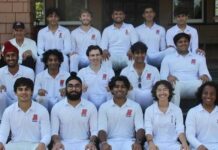With the thoroughly entertaining, if for the Dutch ultimately disappointing, Kathmandu tournament behind us and the domestic Topklasse competition about to get underway, it’s a good moment to look forward to the northern summer, and to assess where the Netherlands are with their long-term project of building a national men’s side less reliant on overseas-produced players.
The really serious business of the first half of the season, of course, is the three-match Super League series against Ireland in Utrecht from 2-7 June, with the Dutch warming up with two ODIs against Scotland in Rotterdam on 19 and 21 May.
But before that, a Netherlands A side will travel to Dublin for three one-day fixtures against Ireland A, giving a bunch of the up-and-comers an opportunity to stake their claim for a place in the senior side.
It seems likely that the squad for the Ireland trip will bear a more than superficial resemblance to that which played in Nepal: of that group, only skipper Pieter Seelaar, batters Max O’Dowd and Ben Cooper, and wicketkeeper Scott Edwards are automatic choices for the side to face Ireland in June.
Assuming that all the Dutch players with county contracts are available for the Super League, there are seven obvious overseas-based contenders for the Super League side: batters Colin Ackermann and Ryan ten Doeschate, allrounders Roelof van der Merwe and Logan van Beek, and the pace trio of Brandon Glover, Timm van der Gugten and Fred Klaassen.
So that makes a full eleven, leaving everyone else from the Kathmandu tournament with some work to do to catch Ryan Campbell’s eye.
Of that party, the Voorburg pairing of Bas de Leede and Philippe Boissevain probably did most to enhance their reputations; De Leede’s unbeaten 81 against Nepal was by far his best innings in Dutch colours, while Boissevain’s bowling, although inconsistent, confirmed that his leg-spin adds a useful dimension to the attack.
Both could benefit from more exposure in Dublin, and quite possibly against Scotland, and the pacemen Viv Kingma and Paul van Meekeren, both well below their best in Nepal, will surely welcome every chance to run into form ahead of the really demanding phases of the Dutch schedule.
The same applies to the debutants from Kathmandu, Aryan Dutt and Julian de Mey, and the young opener Vikram Singh, all of whom had limited opportunities to strut their stuff in a tough competition.
Tonny Staal, squeezed into the middle order in T20, seems likely to get more scope in the 50-over format, especially in the presumed absence in Ireland of O’Dowd, Cooper, Edwards and Seelaar, but it will be interesting to see whether Campbell persists with Tobias Visée, whose 18 runs from four innings did less than justice to his abilities as a hard-hitting opener.
It will also be interesting to see who is brought into the squad for Dublin. Of those from the winter training pool, opening batter Musa Nadeem Ahmad, who warmed up for the Topklasse last Saturday with a hundred for HCC against admittedly weakened opposition, may well be in contention, along with his club-mate Clayton Floyd and Punjab’s Saqib Zulfiqar.
And there are two more Dutch passport-holders waiting in the wings, in the form of South Africans Ryan Klein (HBS Craeyenhout) and Tristan Stubbs (Excelsior ’20), either or both of whom might well be in the running before the Topklasse season is far advanced.
Their arrival, of course, would limit the chances for the home-produced players still further, but the evidence of Kathmandu, and of other series in the past, is that the Dutch struggle against their top Associate rivals, let alone Full Member opposition, when the overseas contingent is missing.
It presents a stark contrast with the 2003 World Cup, when every member of the squad had learned his cricket in the Netherlands, and even with 2007, when eight of the fourteen were home-produced.
The Dutch were outclassed by the Full Members in both tournaments, but they beat Namibia in 2003 and Scotland four years later, achievements which the side from Kathmandu might struggle to emulate.
The selection pool in the Netherlands is certainly smaller now than it was fifteen or twenty years ago, but a more significant factor is probably the progress which other Associates have made over the intervening decades, leaving the Dutch battling to keep pace.
The best the Under-18/19 side has done in the European qualifiers over the past decade was third in 2013, although the presence in this year’s squad of experienced first-team players like Vikram Singh and Aryan Dutt, both of whom were in Nepal, Shirase Rasool, Shreyas Potdar and Pierre Jacod gives rise to hope that this time the Netherlands will be real contenders.
Much will need to change if the Dutch are to realise their ambition of Full membership by 2025/26, and the performances of the A side and Under-18 squad this season will be pointers to just how achievable that goal might be.
You’re reading Emerging Cricket — brought to you by a passionate group of volunteers with a vision for cricket to be a truly global sport, and a mission to inspire passion to grow the game.
Be sure to check out our homepage for all the latest news, please subscribe for regular updates, and follow EC on Twitter, Facebook, LinkedIn and YouTube.
Don’t know where to start? Check out our features list, country profiles, and subscribe to our podcast.
Support us from US$2 a month — and get exclusive benefits, by becoming an EC Patron.

